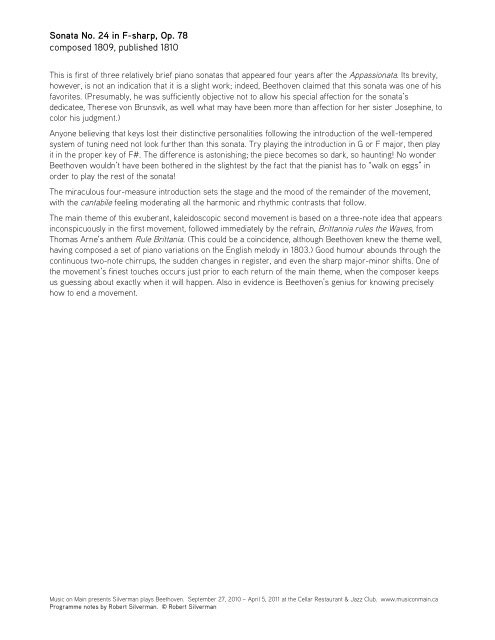beethoven's 32 piano sonatas robert silverman - Music on Main
beethoven's 32 piano sonatas robert silverman - Music on Main
beethoven's 32 piano sonatas robert silverman - Music on Main
You also want an ePaper? Increase the reach of your titles
YUMPU automatically turns print PDFs into web optimized ePapers that Google loves.
S<strong>on</strong>ata No. 24 in F-sharp, Op. 78<br />
composed 1809, published 1810<br />
This is first of three relatively brief <str<strong>on</strong>g>piano</str<strong>on</strong>g> <str<strong>on</strong>g>s<strong>on</strong>atas</str<strong>on</strong>g> that appeared four years after the Appassi<strong>on</strong>ata. Its brevity,<br />
however, is not an indicati<strong>on</strong> that it is a slight work; indeed, Beethoven claimed that this s<strong>on</strong>ata was <strong>on</strong>e of his<br />
favorites. (Presumably, he was sufficiently objective not to allow his special affecti<strong>on</strong> for the s<strong>on</strong>ata’s<br />
dedicatee, Therese v<strong>on</strong> Brunsvik, as well what may have been more than affecti<strong>on</strong> for her sister Josephine, to<br />
color his judgment.)<br />
Any<strong>on</strong>e believing that keys lost their distinctive pers<strong>on</strong>alities following the introducti<strong>on</strong> of the well-tempered<br />
system of tuning need not look further than this s<strong>on</strong>ata. Try playing the introducti<strong>on</strong> in G or F major, then play<br />
it in the proper key of F#. The difference is ast<strong>on</strong>ishing; the piece becomes so dark, so haunting! No w<strong>on</strong>der<br />
Beethoven wouldn’t have been bothered in the slightest by the fact that the pianist has to “walk <strong>on</strong> eggs” in<br />
order to play the rest of the s<strong>on</strong>ata!<br />
The miraculous four-measure introducti<strong>on</strong> sets the stage and the mood of the remainder of the movement,<br />
with the cantabile feeling moderating all the harm<strong>on</strong>ic and rhythmic c<strong>on</strong>trasts that follow.<br />
The main theme of this exuberant, kaleidoscopic sec<strong>on</strong>d movement is based <strong>on</strong> a three-note idea that appears<br />
inc<strong>on</strong>spicuously in the first movement, followed immediately by the refrain, Brittannia rules the Waves, from<br />
Thomas Arne's anthem Rule Brittania. (This could be a coincidence, although Beethoven knew the theme well,<br />
having composed a set of <str<strong>on</strong>g>piano</str<strong>on</strong>g> variati<strong>on</strong>s <strong>on</strong> the English melody in 1803.) Good humour abounds through the<br />
c<strong>on</strong>tinuous two-note chirrups, the sudden changes in register, and even the sharp major-minor shifts. One of<br />
the movement’s finest touches occurs just prior to each return of the main theme, when the composer keeps<br />
us guessing about exactly when it will happen. Also in evidence is Beethoven’s genius for knowing precisely<br />
how to end a movement.<br />
<str<strong>on</strong>g>Music</str<strong>on</strong>g> <strong>on</strong> <strong>Main</strong> presents Silverman plays Beethoven. September 27, 2010 – April 5, 2011 at the Cellar Restaurant & Jazz Club. www.music<strong>on</strong>main.ca<br />
Programme notes by Robert Silverman. © Robert Silverman


